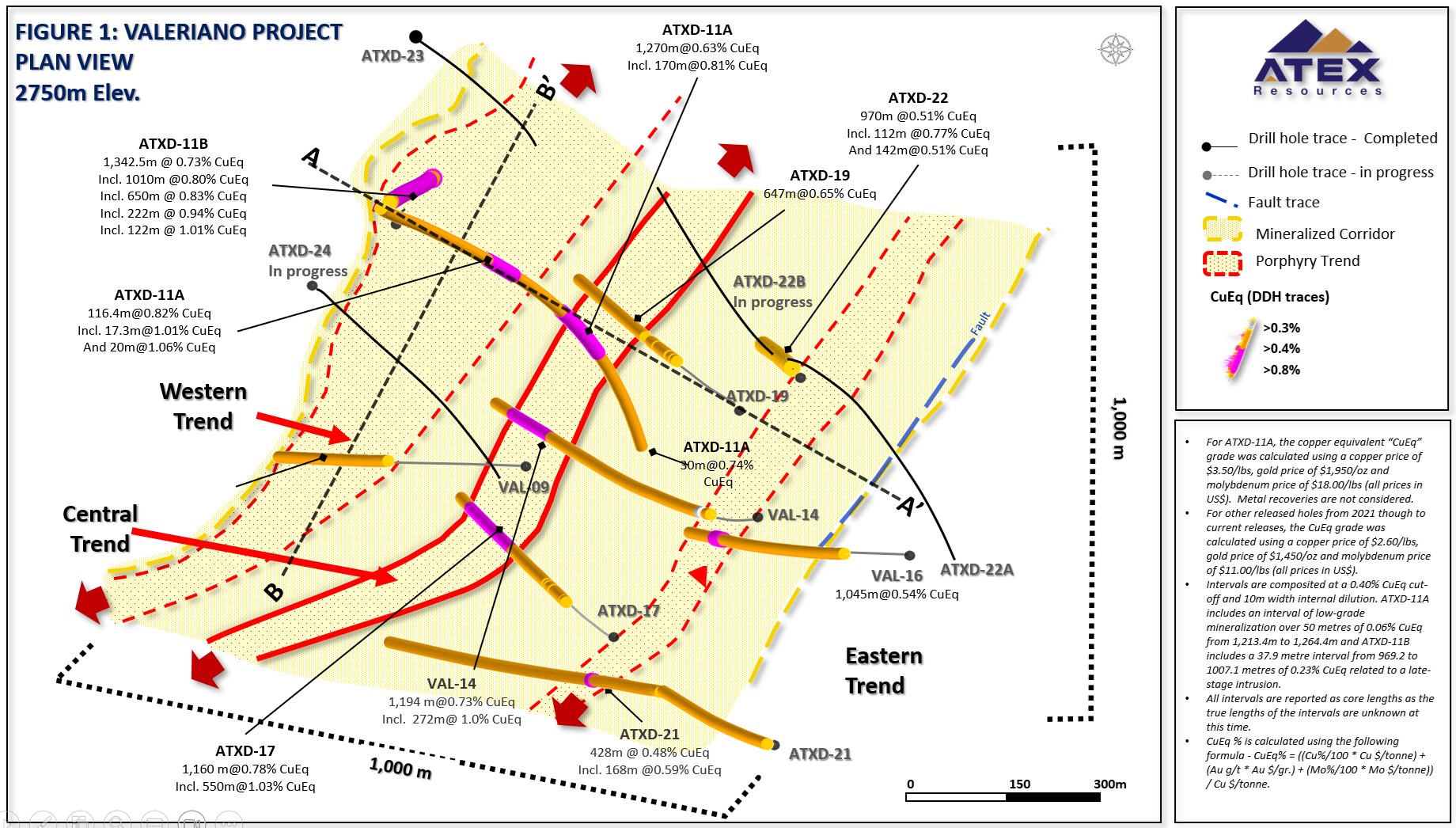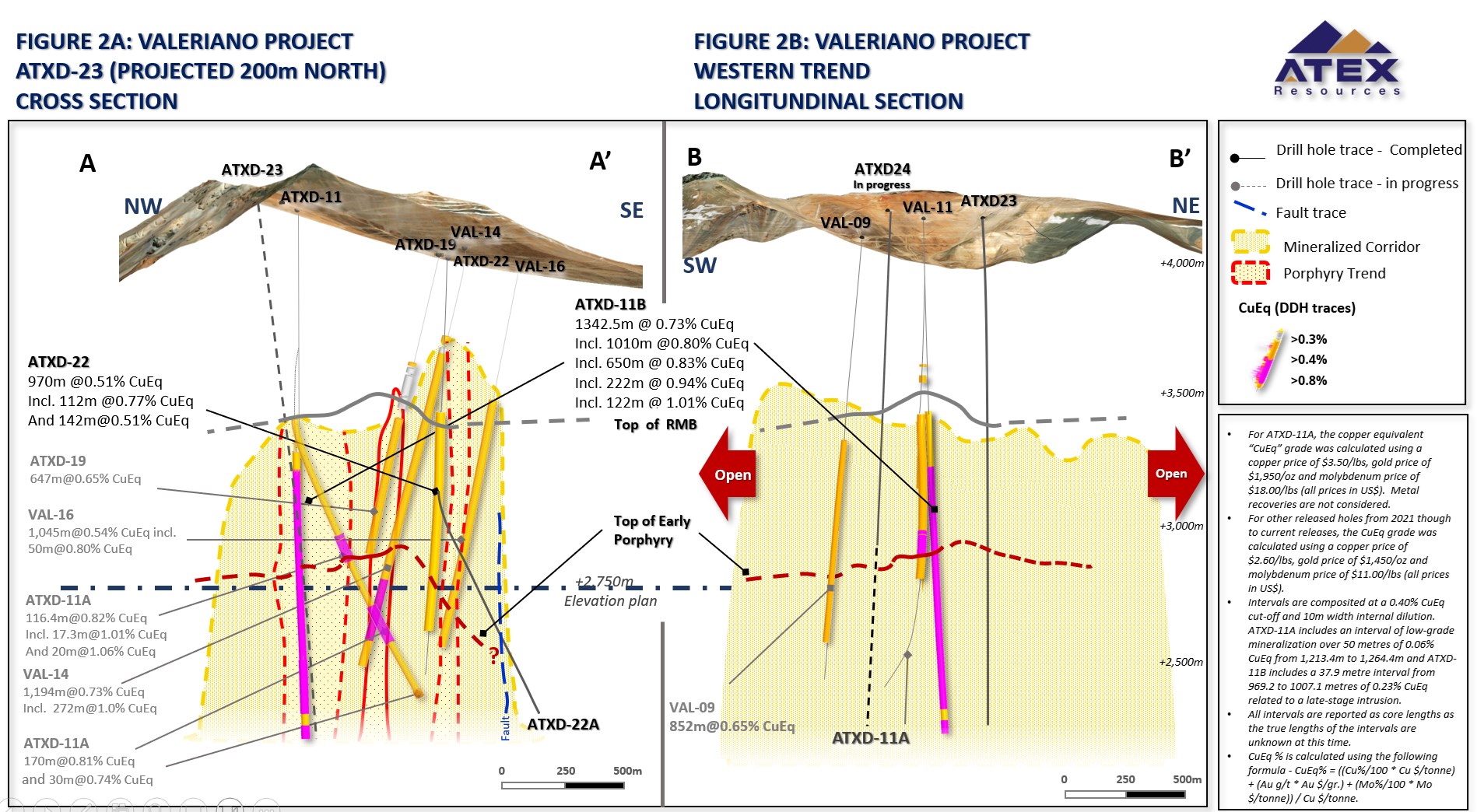
ATEX Resources Inc. (TSXV: ATX), has announced the successful completion of drill holes ATXD-22A and ATXD-23 in their ongoing Phase III exploration at the Valeriano Copper-Gold Project in Chile’s Atacama Region.
Raymond Jannas, President, and CEO of ATEX, commented in a press release: “Our Phase III drill program continues to successfully deliver on its objectives with hole ATXD-23 significantly extending the newly discovered Western Trend which remains open along strike to the northeast. We have now confirmed 750 metres of strike extent along the Western Trend between drill holes VAL-09 and ATXD-23, demonstrating continuity of the geology and mineralization within this new trend.”
The company remains committed to its Phase III campaign objectives, which include the extension of the mineralized corridor, primarily northeastwards, through meticulous step-out drilling. The campaign’s aim is to define the continuity and geometrical attributes of the porphyry trends and to identify new potential targets within this corridor.
Currently, two diamond drill holes, ATXD-24 and ATXD-22B, are in progress. The former, an inclined drill hole, is designed to intersect the Western Trend at a point 200 metres south along the strike from ATXD-11B, with a plan to reach the Central High-Grade Trend at a deeper level. The latter, a “daughter hole”, springs from ATXD-22 and is geared towards exploring the northern extension of the Central High-Grade Trend, stretching 200 metres beyond ATXD-11A.
ATXD-23, another crucial diamond drill hole, was set 200 metres north of ATXD-11B along the Western Trend. It commenced at a -83-degree dip and a 125-degree azimuth. Intriguingly, alteration began 525 metres downhole, where quartz-sericite alteration was encountered in the overlying rhyolitic tuffs. Mineralized RMB chalcopyrite was detected from 825 metres down, with the quartz-sericite alteration gradually transitioning to potassic alteration, intensifying up to 1,500 metres. At this point, the early porphyry unit’s top was intersected, revealing widespread potassic alteration and chalcopyrite from 1,500 metres to the hole’s end at 2,050 metres.
Moreover, ATXD-22A, a daughter hole drilled out of ATXD-22, started at 921 metres downhole at a 135-degree azimuth and a -65-degree dip. The hole began in RMB with chalcopyrite mineralization and weak potassic alteration, extending to a depth of 1,823.1 meters, where a significant fault was intersected, marking the end of the mineralized geology. The hole ultimately concluded at a depth of 1,871 metres.
The final drill holes of the Phase III project are anticipated to be concluded by the end of May, with comprehensive assay results expected by late July. Following the receipt of all assay results, ATEX Resources Inc. plans to revise the copper-gold porphyry resource statement for the Valeriano Project and prepare an updated NI-43 101 compliant technical report. Furthermore, the company will perform metallurgical tests using core samples from the Phase III program.
Highlights from the results are as follows:
- ATXD-23 intersected 550 metres of mineralized early porphyry, between 1,500 and 2,050 metres downhole (Figures 1&2)
- ATXD-23 extends the strike length of the Western Trend by approximately 200 metres north of hole ATXD-11B that intersected 1,342.5 metres of 0.73% CuEq (0.46% Cu, 0.31 g/t Au and 43 ppm Mo) and was released on March 30, 2023.
- Copper mineralization in the early porphyry consists mainly of chalcopyrite and to a lesser extent bornite, consistent with mineralization observed in ATXD-11B.
- Additionally, ATXD-23 intersected 650 metres of chalcopyrite-bearing Rock Milled Breccia (“RMB”) above the early porphyry interval from a depth of 850 metres downhole to the porphyry contact at 1,500 metres.
- ATXD-22A (daughter hole) drilled southeast out of ATDX-22 intersected altered chalcopyrite bearing RMB and mineralized late porphyry units.
- The final two holes of the program, ATXD-24 and ATXD-22B are anticipated to be completed by the end of May.
- Complete assays for ATXD-23 and ATXD-22A are expected by late May.

Figure 2B: Valeriano Project – Western Trend – Longitudinal Section. Source: ATEX Resources



 Follow us on Twitter
Follow us on Twitter Become our facebook fan
Become our facebook fan










Comments are closed.